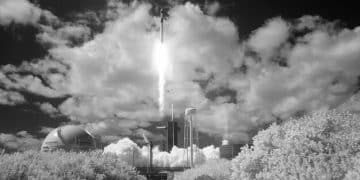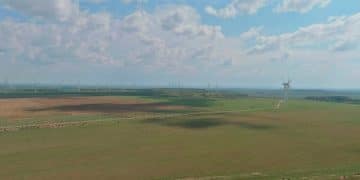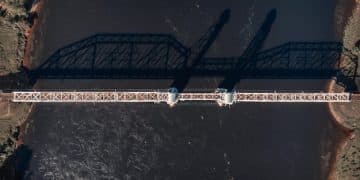Clean Power Plan 2.0 vs. Original: Key Differences Explored

The proposed Clean Power Plan 2.0 represents a significant shift from the original, primarily by focusing on carbon capture and storage technologies and an “all-of-the-above” energy strategy, contrasting with the Obama administration’s emphasis on renewable energy and efficiency targets for states.
Understanding the nuances of environmental policy can be complex, especially when initiatives evolve. A critical area of discussion in climate regulation revolves around the Clean Power Plan. This article delves into What are the Key Differences Between the Proposed Clean Power Plan 2.0 and the Original?, examining their respective approaches to curbing carbon emissions and shaping the energy landscape in the United States.
The Genesis of the Original Clean Power Plan
The original Clean Power Plan (CPP), introduced by the Obama administration in 2015, marked a landmark effort by the Environmental Protection Agency (EPA) to address climate change from power plants. It aimed to reduce carbon emissions from existing fossil fuel-fired power plants, treating carbon dioxide as a pollutant under the Clean Air Act. This move was a cornerstone of the U.S.’s commitment to the Paris Agreement on climate change.
The CPP set state-specific carbon emission reduction targets. States were then given flexibility in how they met these targets, which could involve a mix of strategies such as improving efficiency at coal-fired plants, shifting energy generation from coal to natural gas, and increasing the use of renewable energy sources like wind and solar. This flexibility was intended to allow states to tailor solutions that best fit their economic and energy landscapes.
Core Pillars of the Original CPP
The primary mechanisms through which the original CPP sought to achieve its goals were multifaceted and designed to encourage system-wide changes rather than simply mandating specific technologies. This approach was central to its regulatory framework.
- Heat Rate Improvements: Encouraging existing coal-fired power plants to operate more efficiently, thus reducing the amount of fuel needed per unit of electricity generated and consequently lowering emissions.
- Shifting Generation to Natural Gas: Promoting a transition from higher-emitting coal-fired generation to lower-emitting natural gas plants, as natural gas burns more cleanly than coal.
- Increased Renewable Energy: Advocating for significant investments in and deployment of renewable energy sources, which produce little to no carbon emissions during operation.
The original Clean Power Plan faced immediate legal challenges and political opposition, particularly from states heavily reliant on coal and from industry groups. Critics argued it exceeded the EPA’s authority, would lead to job losses in the coal industry, and impose excessive costs on electricity consumers. Despite these challenges, its intent was clear: to significantly mitigate the environmental impact of electricity generation in the U.S. and drive a national transition towards cleaner energy sources.
The Political and Regulatory Landscape Shift
The transition from the Obama administration to the Trump administration brought a profound shift in environmental policy, particularly concerning climate change and energy regulation. The original Clean Power Plan (CPP) became a prime target for repeal, signaling a departure from the previous administration’s aggressive climate agenda. This reversal was rooted in a different philosophy emphasizing deregulation, perceived economic burdens, and a strong preference for fossil fuel industries.
Upon taking office, the Trump administration swiftly moved to dismantle the regulatory framework of the original CPP. This action was consistent with its broader agenda of rolling back environmental regulations deemed burdensome to businesses and energy producers. The administration argued that the CPP placed an undue burden on the energy sector, stifled economic growth, and exceeded the EPA’s statutory authority under the Clean Air Act. This perspective gained traction among some industry leaders and states, who had long opposed the CPP.
Legal and Administrative Pathways for Repeal
The process of repealing the original CPP was complex, involving both legal challenges and administrative rulemaking. The Supreme Court had already issued a stay on the CPP in 2016, preventing its implementation while legal challenges progressed. This stay was a significant blow to the plan’s viability and foreshadowed its eventual undoing.
The Trump EPA then initiated the formal process of repealing the CPP, arguing it was unlawful. Concurrently, it proposed a replacement rule, the Affordable Clean Energy (ACE) rule, which was eventually adopted. The ACE rule represented a dramatically different approach, focusing almost exclusively on efficiency improvements at individual power plants rather than broader, system-wide changes to the energy grid.
This period was characterized by intense legal battles and public debate. Environmental groups, some states, and renewable energy advocates argued vehemently against the repeal, asserting that it undermined efforts to combat climate change and protect public health. The clash reflected fundamental disagreements about the role of federal regulation in environmental protection and the urgency of addressing climate change. The political will to pursue a vastly different energy and climate policy directly led to the conceptualization and eventual proposal of what we now refer to as the “Clean Power Plan 2.0” – a title often informally applied to the subsequent regulatory frameworks and policy proposals that emerged as replacements or alternatives.
Introducing the Proposed Clean Power Plan 2.0 (ACE Rule)
The term “Clean Power Plan 2.0” is often used informally to refer to the Affordable Clean Energy (ACE) rule, which was proposed and finalized by the EPA under the Trump administration. This rule was designed to replace the original Clean Power Plan, reflecting a starkly different philosophy regarding carbon emission regulation from power plants. It marked a significant shift from an “outside-the-fence-line” approach, which considered broader grid-wide changes, to an “inside-the-fence-line” approach focused on individual facilities.
The ACE rule’s central tenet was that the EPA’s authority under the Clean Air Act was limited to regulating emissions at the source, specifically through “best system of emission reduction” (BSER) that could be applied at, or in, a power plant. This interpretation significantly narrowed the scope of what the EPA could mandate compared to the original CPP, which allowed for a range of measures including renewable energy development and demand-side management.

Key Paradigms and Differences in Approach
The contrast between the original CPP and the proposed Clean Power Plan 2.0 (ACE rule) can be understood through several key differences in their underlying paradigms and regulatory mechanisms. These distinctions highlight fundamental disagreements about the scope of federal environmental authority and the most effective ways to reduce carbon emissions.
- Best System of Emission Reduction (BSER): The original CPP identified three “building blocks” of emission reduction that extended beyond the fenceline of individual plants (efficiency improvements, natural gas utilization, and renewable energy). The ACE rule, conversely, limited BSER to only heat rate improvements at individual power plants, a much narrower interpretation.
- State Role and Flexibility: While both plans offered states flexibility, the nature of that flexibility differed greatly. The ACE rule tasked states with developing specific emission guidelines for existing plants, but only based on the limited BSER identified by the EPA. The original CPP gave states broader leeway to choose from a wider array of compliance mechanisms to meet overall state targets.
- Emissions Reduction Targets: The original CPP set ambitious, specific national and state-level carbon reduction targets. The ACE rule, by focusing on individual plant efficiency, was projected to result in significantly smaller, if any, overall emission reductions from the power sector, and its targets were not as explicit or stringent.
Essentially, the ACE rule was predicated on the idea that states, not the federal government, should have primary authority over energy policy decisions and that federal regulations should not mandate significant shifts in energy mixes. It reflected a philosophy favoring incremental changes at existing facilities rather than transformational changes across the entire electricity grid. This approach was designed to minimize perceived economic disruption to the fossil fuel industry, particularly coal. However, it also drew strong criticism for its limited environmental impact and its departure from established climate science consensus.
Core Differences in Regulatory Mechanisms
The fundamental distinction between the original Clean Power Plan (CPP) and the ACE rule, often informally called “CPP 2.0,” lies in their chosen regulatory mechanisms and the legal interpretations that underpinned them. These differences reflect contrasting philosophies on how to best regulate carbon emissions from existing power plants and the extent of the EPA’s authority under the Clean Air Act.
The original CPP employed a broad, multi-faceted approach. It identified a “best system of emission reduction” (BSER) that comprised three “building blocks”: improving efficiency at coal-fired power plants, shifting generation from coal to natural gas, and increasing renewable energy. This comprehensive view allowed for “outside-the-fenceline” measures, meaning actions taken beyond a single power plant, such as investing in wind farms or solar arrays, could count towards a state’s compliance. The flexibility offered to states was significant, allowing them to choose the most cost-effective mix of strategies to meet their individual emission reduction targets, which were set at an aggregate state level.
“Inside-the-Fenceline” vs. “Outside-the-Fenceline”
This contrast of “inside-the-fenceline” versus “outside-the-fenceline” is perhaps the most critical regulatory divergence. The original CPP permitted states to achieve their targets through demand-side energy efficiency improvements and renewable energy deployment, which happen “outside” the physical boundaries of the fossil fuel power plant itself. This holistic approach aimed to transform the power sector as a whole.
- Original CPP: Utilized a “system-wide” approach, encouraging shifts in the electricity generation mix (e.g., from coal to renewables) and broader energy efficiency measures. It set state-specific targets for overall carbon emissions reductions.
- ACE Rule (“CPP 2.0”): Adopted an “inside-the-fenceline” approach, limiting emission reduction measures to those that could be implemented at an individual power plant. This primarily meant efficiency upgrades (heat rate improvements) and did not include fuel switching or renewable energy development as compliance methods under the federal rule.
Another significant difference lay in the stringency of the targets and the projected emission reductions. The original CPP set ambitious and legally binding targets for states, aiming for a 32% reduction in carbon emissions from the power sector by 2030, relative to 2005 levels. The ACE rule, by contrast, projected much smaller (if any) reductions, estimated to be between 0.7% and 1.5% by 2030 compared to unregulated levels, essentially codifying what many plants were already doing or planning. This vastly different projected impact underscored the fundamental philosophical divide between the two approaches: one aimed at transformative change, the other at minimal intervention.
Economic and Environmental Implications
The divergent regulatory mechanisms of the original Clean Power Plan (CPP) and the proposed Clean Power Plan 2.0 (ACE rule) led to vastly different projected economic and environmental implications. These differences were at the heart of the political and public debate surrounding both policies, with stakeholders often holding conflicting views on their potential impacts.
From an environmental standpoint, the original CPP was designed to deliver significant reductions in carbon emissions, a primary driver of climate change. The EPA projected that by 2030, the CPP would cut carbon emissions from the power sector by 32% compared to 2005 levels. This was anticipated to yield substantial climate benefits, including avoided climate damages from extreme weather events, sea-level rise, and other climate impacts. Additionally, the shift towards cleaner energy sources was expected to reduce emissions of other harmful air pollutants, leading to improved public health outcomes, such as fewer premature deaths, asthma attacks, and lost workdays. These health benefits were often cited as a critical co-benefit of the original CPP.
Contrasting Economic Projections
Economically, the original CPP was projected to impose compliance costs on power generators, but these costs were expected to be offset by improvements in energy efficiency and shifts to lower-cost renewable energy. Supporters argued it would spur innovation, create jobs in the clean energy sector, and lead to long-term electricity bill savings for consumers. Critics, however, focused on potential job losses in the coal industry and increased electricity prices, though these claims were often disputed by EPA analyses.
- Original CPP: Projected significant public health benefits and substantial reductions in carbon emissions. Economic impacts uncertain, with potential job growth in renewables but concerns over coal industry decline and electricity costs.
- ACE Rule (“CPP 2.0”): Projected negligible environmental benefits due to limited carbon reduction potential. Economic impacts argued to be minimal compliance costs for industry, but also minimal economic upside from clean energy investment.
Conversely, the ACE rule (“CPP 2.0”) was projected to have a much smaller environmental impact. As it focused primarily on heat-rate improvements at individual plants, its projected carbon emission reductions were minimal, often estimated at less than 2% by 2030 compared to a no-action baseline. Consequently, the public health and climate benefits associated with the ACE rule were also projected to be negligible. The economic argument for the ACE rule centered on reducing regulatory burdens on power companies, particularly coal-fired plants, and avoiding the costs associated with potentially retiring older, less efficient facilities. While this might have offered a short-term reprieve for some fossil fuel operations, critics argued it stifled investment in cleaner technologies and positioned the U.S. to fall behind in the global clean energy transition, ultimately leading to greater long-term economic and environmental costs.
Legal Challenges and the Future Outlook
Both the original Clean Power Plan (CPP) and its replacement, the Affordable Clean Energy (ACE) rule (informally “CPP 2.0”), have been embroiled in extensive legal battles, underscoring the deep divisions in U.S. environmental policy. The legal challenges reflect fundamental disagreements over regulatory authority, economic impact, and the urgency of climate action. These legal battles have significantly shaped the trajectory of carbon emissions regulation from power plants in the United States.
The original CPP faced immediate and widespread legal opposition. A coalition of states, industry groups, and coal companies challenged the rule in federal court shortly after it was finalized. They argued that the EPA had overstepped its authority under the Clean Air Act, particularly by attempting to regulate “outside the fenceline” of individual power plants. In an unprecedented move, the Supreme Court issued a stay on the CPP’s implementation in 2016, effectively halting it before it could take effect. This stay suggested that a majority of the Court had serious concerns about the legality of the rule, creating a significant legal hurdle that the incoming Trump administration capitalized on to justify its repeal.

Ongoing Legal Battles and Policy Uncertainty
The ACE rule (“CPP 2.0”) also faced its own set of legal challenges. Environmental groups, several states, and public health organizations sued the EPA, arguing that the ACE rule was insufficient to address carbon pollution and that the agency had a legal obligation to regulate emissions more stringently under the Clean Air Act. These lawsuits specifically challenged the EPA’s narrow interpretation of “best system of emission reduction,” arguing that it failed to adequately protect public health and welfare from climate pollution. The D.C. Circuit Court of Appeals ultimately vacated the ACE rule in 2021, finding that the EPA’s interpretation of its authority was too restrictive and that the rule did not adequately respond to the climate crisis.
The legal vacuum created by the effective demise of both the original CPP (due to the Supreme Court stay and subsequent repeal) and the ACE rule (due to the D.C. Circuit’s vacatur) means that the U.S. EPA faces renewed pressure to develop a new, legally robust framework for regulating carbon emissions from existing power plants. The Supreme Court’s decision in West Virginia v. EPA (2022) further complicated matters, limiting the EPA’s authority to mandate broad “outside-the-fenceline” measures without explicit congressional authorization, reaffirming the “major questions doctrine.” This ruling significantly constrains how any future “Clean Power Plan 3.0” might be structured, likely necessitating an “inside-the-fenceline” approach or requiring new legislative action from Congress to grant the EPA broader authority. The future outlook for comprehensive federal climate regulation in the U.S. power sector remains highly uncertain, subject to ongoing legal interpretation and political will.
Impact on the Energy Sector
The regulatory shifts from the original Clean Power Plan (CPP) to the proposed Clean Power Plan 2.0 (ACE rule) have profound implications for the U.S. energy sector. These policy changes influence investment decisions, fuel choices, and the overall trajectory of power generation. Understanding these impacts is crucial for assessing the long-term viability and sustainability of different energy sources.
The original CPP, despite its legal challenges and eventual repeal, spurred significant discussions and strategic planning within the energy industry. Its emphasis on reducing reliance on coal, encouraging natural gas, and promoting renewables accelerated an existing market trend. Many utilities and states began to invest more heavily in natural gas and renewable energy technologies, partly in anticipation of the CPP’s requirements. This proactive shift often predated the rule’s effective implementation, demonstrating the power of regulatory signals to influence market behavior. Consequently, the decline of coal-fired power generation, driven by economic factors (cheap natural gas, declining renewable costs) and increased environmental awareness, continued even after the CPP’s stymied progress.
Investment and Innovation
The ACE rule (“CPP 2.0”), by contrast, was designed to provide a lifeline to existing coal-fired power plants by focusing solely on efficiency improvements. While intended to reduce the regulatory burden on these facilities, it offered little incentive for broader, transformative investments in clean energy. Critics argued that this approach could lock in older, higher-emitting infrastructure, hindering innovation in more advanced clean technologies in the U.S. This limited scope meant that while some coal plants might have seen minor upgrades, the overall sector-wide transition to lower-carbon energy was not explicitly incentivized by the federal regulation.
- Original CPP: Catalyzed investment in renewables and natural gas, accelerating the shift away from coal due to anticipated regulatory requirements and market signals.
- ACE Rule (“CPP 2.0”): Offered limited incentives for clean energy transition, predominantly focusing on incremental efficiency improvements at existing coal plants, potentially slowing broader decarbonization efforts in the U.S. power sector.
Ultimately, the legal and political uncertainty surrounding federal carbon regulation has created a challenging environment for long-term energy planning. Utilities and investors prefer regulatory predictability. The on-again, off-again nature of these plans has sometimes led to a patchwork of state-level policies and private sector initiatives driving decarbonization, rather than a cohesive national strategy. While market forces continue to favor cleaner and cheaper energy, the absence of a stable federal framework means the pace and scale of the energy transition in the U.S. remain subject to significant debate and external factors.
Future Directions for US Climate Policy
The trajectory of U.S. climate policy, particularly concerning the power sector, remains a complex and evolving landscape. Following the vacatur of the ACE rule (“CPP 2.0”) and the Supreme Court’s limiting decision in West Virginia v. EPA, the Environmental Protection Agency (EPA) is once again tasked with developing a new, legally defensible framework for regulating carbon emissions from existing power plants. This ongoing process highlights the persistent need for effective policy to address climate change while navigating legal constraints and political realities.
The Biden administration has made climate change a central pillar of its policy agenda, rejoining the Paris Agreement and setting ambitious goals for decarbonizing the U.S. economy, including a target of 100% carbon pollution-free electricity by 2035. Achieving these goals will require significant regulatory action and investment. However, the Supreme Court’s ruling in West Virginia v. EPA limits the EPA’s ability to implement broad “generation-shifting” policies (like the original CPP’s focus on renewables and natural gas) under Section 111(d) of the Clean Air Act without clearer congressional authorization. This means future regulations regarding power plant emissions will likely focus on “inside-the-fenceline” measures, such as carbon capture and storage (CCS) technologies or co-firing with cleaner fuels, or require new legislative action.
Technological Solutions and Legislative Action
In response to these constraints, there is a growing emphasis on technological solutions and the potential for new legislative action. Technologies like carbon capture, utilization, and storage (CCUS) are gaining renewed attention as potential pathways for existing fossil fuel plants to reduce their emissions. While expensive and challenging to deploy at scale, advancements in these areas could play a role in future regulatory strategies. Furthermore, the Build Back Better Act (though not passed in its original form) and other proposed legislation signaled a willingness in Congress to potentially provide new authorities or incentives for climate action, including significant tax credits for clean energy deployment and CCUS.
- Focus on CCS and Efficiency: Future EPA regulations for existing power plants under the Clean Air Act will likely emphasize “inside-the-fenceline” technologies like carbon capture or enhanced efficiency measures due to recent Supreme Court rulings.
- Role of Federal Incentives: Broader decarbonization efforts will increasingly rely on federal incentives and investments (e.g., through the Inflation Reduction Act) to accelerate renewable energy deployment, electric vehicle adoption, and energy efficiency across sectors, complementing regulatory efforts.
Beyond direct regulation, broader federal initiatives, such as the Inflation Reduction Act, are injecting substantial investments and tax credits into clean energy development, manufacturing, and deployment. These economic incentives are crucial for accelerating the transition to a low-carbon economy, potentially achieving significant emission reductions even without some of the direct regulatory mandates seen in the original CPP. The future of U.S. climate policy will likely involve a combination of targeted “inside-the-fenceline” regulations, robust federal investments in clean energy technologies, and ongoing efforts to build consensus for comprehensive legislative solutions to achieve ambitious climate targets.
| Key Aspect | Brief Description |
|---|---|
| 🎯 Target Scope | Original: Broad, state-level emissions. 2.0 (ACE): Plant-specific efficiency. |
| 🛠️ Regulatory Tools | Original: System-wide changes (renewables, gas). 2.0 (ACE): Heat rate improvements. |
| 📉 Emission Reduction | Original: Significant national cuts. 2.0 (ACE): Negligible or minimal reductions. |
| ⚖️ Legal Basis | Original: Broader Section 111(d) interpretation. 2.0 (ACE): Narrower “inside-the-fenceline” BSER. |
Frequently Asked Questions About the Clean Power Plans
▼
The original Clean Power Plan aimed to reduce carbon emissions from existing fossil fuel-fired power plants, treating carbon dioxide as an air pollutant. It set state-specific targets for emission reductions, allowing states flexibility to meet these goals through various means, including improving plant efficiency, shifting to natural gas, and increasing renewable energy use across their power grids.
▼
The Clean Power Plan 2.0, or Affordable Clean Energy (ACE) Rule, fundamentally shifted the regulatory approach by focusing exclusively on “inside-the-fenceline” efficiency improvements at individual power plants. Unlike the original, it did not allow for broader, system-wide changes like renewable energy development or fuel switching as part of federal compliance, significantly narrowing the scope of emission reduction measures.
▼
The original CPP was projected to deliver substantial carbon emission cuts (e.g., 32% by 2030 from 2005 levels), yielding significant public health and climate benefits. The ACE Rule, conversely, was projected to result in minimal, if any, carbon reductions (estimated at less than 2% by 2030), leading to far fewer environmental and health benefits compared to its predecessor.
▼
Both plans faced legal challenges primarily due to differing interpretations of the EPA’s authority under the Clean Air Act. The original CPP was challenged for overstepping its authority with “outside-the-fenceline” measures. The ACE Rule was challenged for being too restrictive and failing to adequately address carbon pollution, suggesting it did not fulfill the EPA’s legal obligations to regulate emissions effectively.
▼
Currently, neither the original Clean Power Plan nor the ACE Rule is in effect. The original CPP was stayed by the Supreme Court and later repealed. The ACE Rule was vacated by a federal appeals court, and subsequent Supreme Court rulings have further limited the EPA’s regulatory scope. The EPA is now working on a new rule under new legal interpretations, likely focusing on “inside-the-fenceline” solutions or requiring new legislative support.
Conclusion
The journey from the original Clean Power Plan to its proposed successor, the Affordable Clean Energy (ACE) rule, highlights a pivotal ideological and legal battle over federal environmental regulation in the United States. While the original plan sought to drive a transformative, system-wide shift towards cleaner energy through broad, flexible state targets, the ACE rule adopted a much narrower, plant-specific approach focused primarily on efficiency improvements. These distinctions reflect fundamental disagreements over regulatory authority, the scale of necessary emission reductions, and the economic impact on the energy sector. As the U.S. continues to grapple with climate change, the evolution of these policies underscores the complex interplay between environmental imperatives, legal interpretations, and political will, shaping the future of electricity generation and carbon mitigation efforts.





